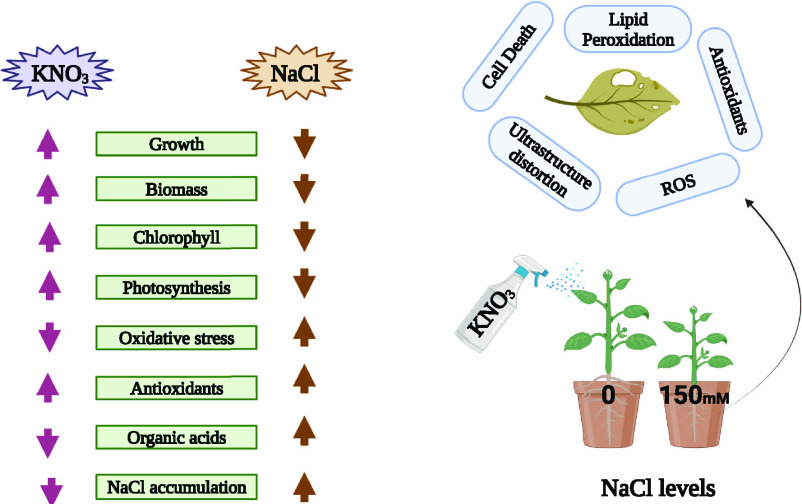- Record: found
- Abstract: found
- Article: found
Ameliorative Effects of Exogenous Potassium Nitrate on Antioxidant Defense System and Mineral Nutrient Uptake in Radish ( Raphanus sativus L.) under Salinity Stress

Read this article at
Abstract

Soil salinization has become a major issue around the world in recent years, as it is one of the consequences of climate change as sea levels rise. It is crucial to lessen the severe consequences of soil salinization on plants. A pot experiment was conducted to regulate the physiological and biochemical mechanisms in order to evaluate the ameliorative effects of potassium nitrate (KNO 3) on Raphanus sativus L. genotypes under salt stress. The results from the present study illustrated that the salinity stress induced a significant decrease in shoot length, root length, shoot fresh weight, shoot dry weight, root fresh weight, root dry weight, number of leaves per plant, leaf area chlorophyll-a, chlorophyll-b, total chlorophyll, carotenoid, net photosynthesis, stomatal conductance, and transpiration rate by 43, 67, 41, 21, 34, 28, 74, 91, 50, 41, 24, 34, 14, 26, and 67%, respectively, in a 40 day radish while decreased by 34, 61, 49, 19, 31, 27, 70, 81, 41, 16, 31, 11, 21, and 62%, respectively, in Mino radish. Furthermore, MDA, H 2O 2 initiation, and EL (%) of two varieties (40 day radish and Mino radish) of R. sativus increased significantly ( P < 0.05) by 86, 26, and 72%, respectively, in the roots and also increased by 76, 106, and 38% in the leaves in a 40 day radish, compared to the untreated plants. The results also elucidated that the contents of phenolic, flavonoids, ascorbic acid, and anthocyanin in the two varieties (40 day radish and Mino radish) of R. sativus increased with the exogenous application of KNO 3 by 41, 43, 24, and 37%, respectively, in the 40 day radish grown under the controlled treatments. Results indicated that implementing KNO 3 exogenously in the soil increased the activities of antioxidants like SOD, CAT, POD, and APX by 64, 24, 36, and 84% in the roots and also increased by 21, 12, 23, and 60% in the leaves of 40 day radish while also increased by 42, 13, 18, and 60% in the roots and also increased by 13, 14, 16, and 41% in the leaves in Mino radish, respectively, in comparison to those plants grown without KNO 3. We found that KNO 3 substantially improved plant growth by lowering the levels of oxidative stress biomarkers, thereby further stimulating the antioxidant potential system, which led to an improved nutritional profile of both R. sativus L. genotypes under normal and stressed conditions. The current study would offer a deep theoretical foundation for clarifying the physiological and biochemical mechanisms by which the KNO 3 improves salt tolerance in R. sativus L. genotypes.
Related collections
Most cited references88
- Record: found
- Abstract: found
- Article: not found
Rapid determination of free proline for water-stress studies
- Record: found
- Abstract: found
- Article: not found
Abiotic stress, the field environment and stress combination.
- Record: found
- Abstract: not found
- Article: not found